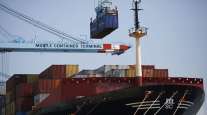Future Chassis Supply Uncertain for Intermodal
This story appears in the Nov. 26 print edition of Transport Topics.
ANAHEIM, Calif. — Uneasiness is mounting about the future supply of intermodal chassis because no single source has yet emerged to supply equipment, freight industry executives said.
Trucker, ocean carrier, railroad and shipper representatives delivered that message Nov. 12 at the National Industrial Transpor-tation League’s TransComp and the Intermodal Association of North America’s Expo here.
“We are getting prepared for a tsunami or a nightmare,” said Barry Michaels, vice president of intermodal operations for Union Pacific Railroad, because at least five approaches to chassis supply are being pursued.
The multiple approaches have developed since 2009, when ocean carriers began to move away from the traditional ap-proach of offering chassis to truckers for free and began charging to use the equipment. That change followed a new federal law that made equipment owners responsible for equipment safety while chassis were on the road.
One of five options laid out by panel moderator Steve Rubin, a principal at consultant InterPro Advisory, is the recently announced non-profit North American Chassis Pool Cooperative being organized by American Trucking Associations’ Intermodal Motor Carrier Conference.
Another choice is the existing Consolidated Chassis Management pool, created by an ocean carrier trade group to provide chassis for daily rental, also without making a profit.
In addition to those approaches, Rubin said, leasing companies such as Flexi-Van and TRAC also are options, as is Direct Chassis Link Inc., a former chassis rental subsidiary of largest ocean carrier Maersk Inc., which began the chassis exodus in 2009.
A fourth prospect he outlined would be a hybrid of those three approaches.
Still other choices announced in recent weeks are chassis pools in Virginia and Southern California controlled by ports.
“With so many players looking at models, there is very little dialogue between inland rail operators [such as Union Pacific] and providers,” Michaels said.
“How will railroads support multiple [chassis] pools?” he asked.
“We haven’t heard a lot about what will happen two or three years from now,” Michaels added. “There is a huge risk around the excitement of [ocean carriers] vacating chassis.”
“From my members’ perspective, there is concern” about the evolution, said Jon Gold, vice president of supply chain and logistics for the National Retail Federation trade group. “Multiple models are inefficient. Shippers don’t want to get into [supplying] chassis themselves. They want pro-viders to do it.”
Gold also said shippers need more information about changing chassis supply approaches — and time to adjust.
“They are willing to support the system, but they have to know how it will work,” he said. “It is going to take time to figure this all out.”
Other panelists mixed concern with optimism.
“What is not working well for us is the way transition has taken place,” said David Manning, president of Tennessee Express and chairman of the ATA group. “It’s very confusing for our customers and our operations and billing personnel.”
“We felt the only way we could have a say in the transition was to own or lease” chassis, Manning said. He also said truckers “have adapted pretty well” to the transition that began three years ago.
“We believe it’s necessary to have purchasing power,” said Manning, because many fleets individually couldn’t afford to buy thousands of chassis at once.
Manning also said CCM is being considered as an option to manage the truckers’ pool once it’s started.
He added that “there are a number of different models that are going to make sense. There is a place for everybody in different environments.”
Mike Wilson, senior vice president of business operations for Hamburg Sud, a German ocean carrier, defended the CCM approach, saying it “has proved to be an effective operation. It allows all stakeholders to participate as we go forward to move from steamship lines to entities who want to operate chassis.”
He also said that, in the future, shippers won’t be able to use chassis as temporary storage to hold container shipments that they don’t want to unload because someone will have to pay for that equipment somehow.
“If we are talking about velocity and efficiency, that can’t continue,” Wilson said.
“In the past, that has been nebulous,” he said, referring to the expense of supplying a chassis, which typically has been rolled into the overall price the ocean carrier charged for the shipment.




